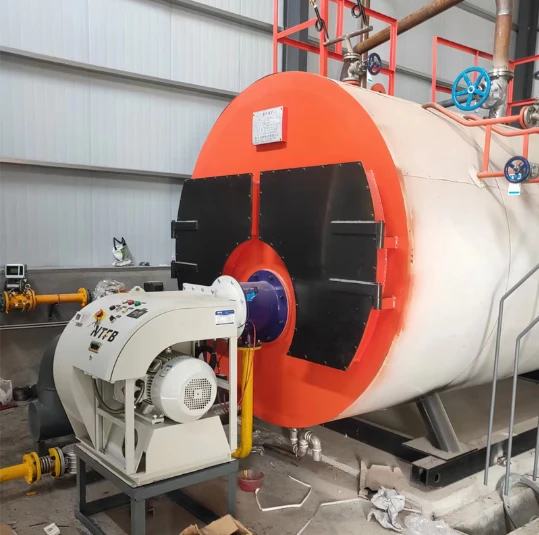
Mar . 04, 2025 02:56 Back to list
biomass fired steam boiler
Blowing down a steam boiler is a critical maintenance procedure that ensures the system operates efficiently and safely. This process involves discharging water from the boiler to remove accumulated impurities and maintain optimal water chemistry. Knowing how often to perform a blowdown can be the difference between a boiler running smoothly and one facing frequent issues or inefficiencies.
Professional boiler operators often suggest initiating with daily blowdowns to establish a baseline for your particular system. This period of observation allows operators to closely monitor the accumulation rate of impurities and system performance, gradually adjusting the frequency based on observed conditions. Conducting Tests and Analyses Regular analysis of boiler water is essential in forming a precise blowdown strategy. Testing kits and periodic laboratory analyses provide vital data about the levels of total dissolved solids (TDS) and other pertinent parameters. By maintaining TDS within recommended limits, operators can optimize blowdown frequency, improving efficiency and preventing potential damage. Balancing Safety with Efficiency The safety of the boiler and plant personnel must be the guiding principle in determining blowdown frequency. Neglecting adequate blowdown schedules can lead to hazardous conditions such as pressure buildup and boiler failure. Conversely, excessive blowdowns waste energy and water, highlighting the necessity for a balanced approach. Implementing Automatic Blowdown Systems Technological advancements have allowed for more sophisticated blowdown processes, including the implementation of automatic blowdown systems. These systems offer real-time monitoring and adjustment of blowdown frequency, reducing the need for manual intervention while optimizing efficiency and resource use. Facilities that handle significant steam loads or complex operations benefit greatly from such automation, ensuring consistent performance without overburdening human operators. Conclusion Determining the optimal blowdown frequency for a steam boiler is a multifaceted decision that must account for water quality, boiler type, operating conditions, and the specific demands of the operation. Relying on expertise and consistent water testing forms the foundation of an effective blowdown strategy, ensuring the longevity, safety, and efficiency of steam boiler operations. By embracing technological solutions like automatic blowdown systems, facilities can further enhance their maintenance regimens, paving the way for reliable and optimized boiler performance.


Professional boiler operators often suggest initiating with daily blowdowns to establish a baseline for your particular system. This period of observation allows operators to closely monitor the accumulation rate of impurities and system performance, gradually adjusting the frequency based on observed conditions. Conducting Tests and Analyses Regular analysis of boiler water is essential in forming a precise blowdown strategy. Testing kits and periodic laboratory analyses provide vital data about the levels of total dissolved solids (TDS) and other pertinent parameters. By maintaining TDS within recommended limits, operators can optimize blowdown frequency, improving efficiency and preventing potential damage. Balancing Safety with Efficiency The safety of the boiler and plant personnel must be the guiding principle in determining blowdown frequency. Neglecting adequate blowdown schedules can lead to hazardous conditions such as pressure buildup and boiler failure. Conversely, excessive blowdowns waste energy and water, highlighting the necessity for a balanced approach. Implementing Automatic Blowdown Systems Technological advancements have allowed for more sophisticated blowdown processes, including the implementation of automatic blowdown systems. These systems offer real-time monitoring and adjustment of blowdown frequency, reducing the need for manual intervention while optimizing efficiency and resource use. Facilities that handle significant steam loads or complex operations benefit greatly from such automation, ensuring consistent performance without overburdening human operators. Conclusion Determining the optimal blowdown frequency for a steam boiler is a multifaceted decision that must account for water quality, boiler type, operating conditions, and the specific demands of the operation. Relying on expertise and consistent water testing forms the foundation of an effective blowdown strategy, ensuring the longevity, safety, and efficiency of steam boiler operations. By embracing technological solutions like automatic blowdown systems, facilities can further enhance their maintenance regimens, paving the way for reliable and optimized boiler performance.
Share
Latest News
-
Efficient Biomass Fired Hot Water Boiler | AI Heating Solution
NewsAug.01,2025
-
High-Efficiency Gas Thermal Oil Boilers | HPT Models
NewsJul.31,2025
-
Oil Fired Hot Water Boilers Sale - High Efficiency & Affordable
NewsJul.31,2025
-
High-Efficiency Commercial Oil Fired Steam Boiler for Industry
NewsJul.30,2025
-
High-Efficiency Biomass Fired Thermal Oil Boiler Solutions
NewsJul.30,2025
-
High Efficiency Gas Fired Thermal Oil Boiler for Industrial Heating
NewsJul.29,2025
Related PRODUCTS
Copyright © 2025 HEBEI HONGZE BOILER MANUFACTURING CO., LTD. All Rights Reserved. Sitemap | Privacy Policy






















